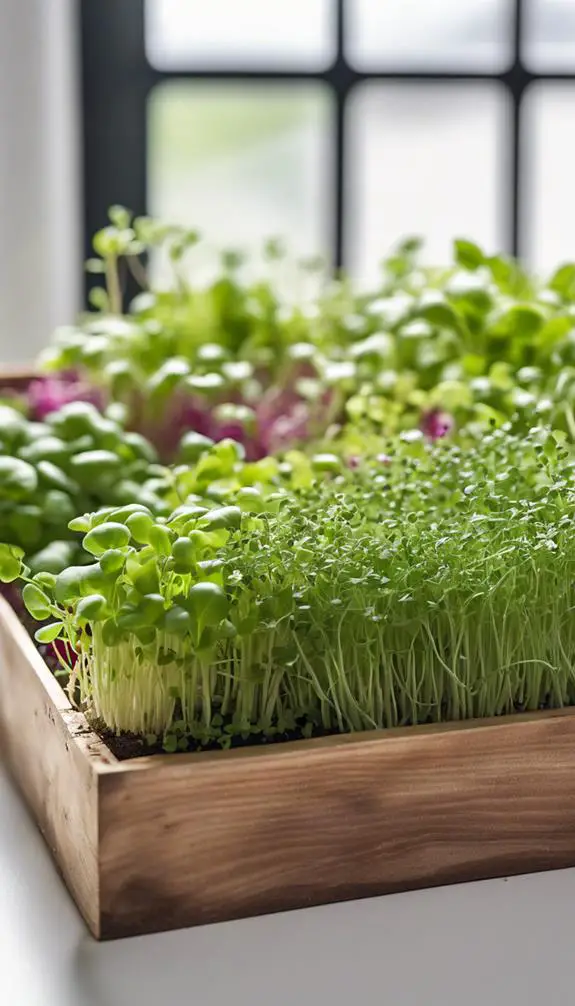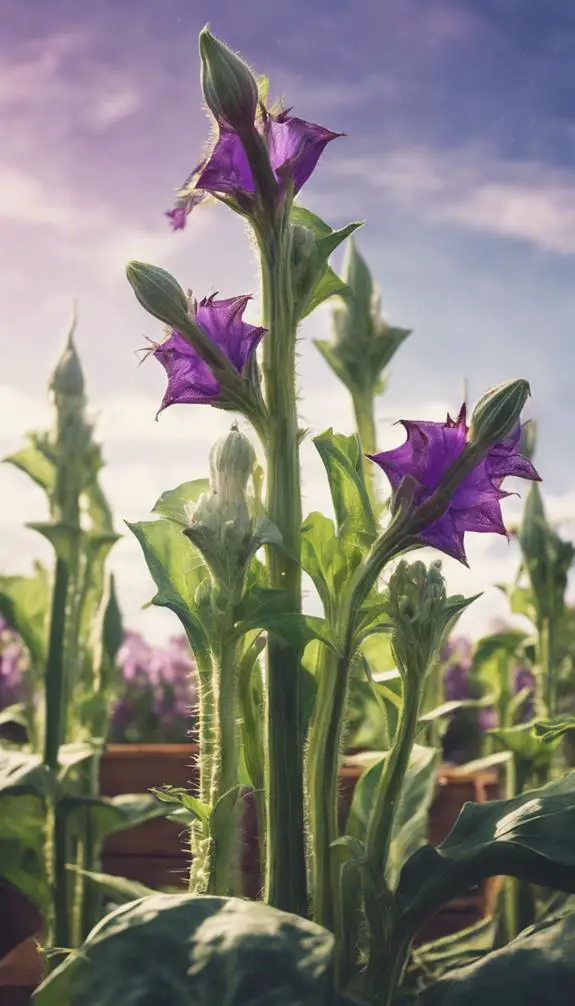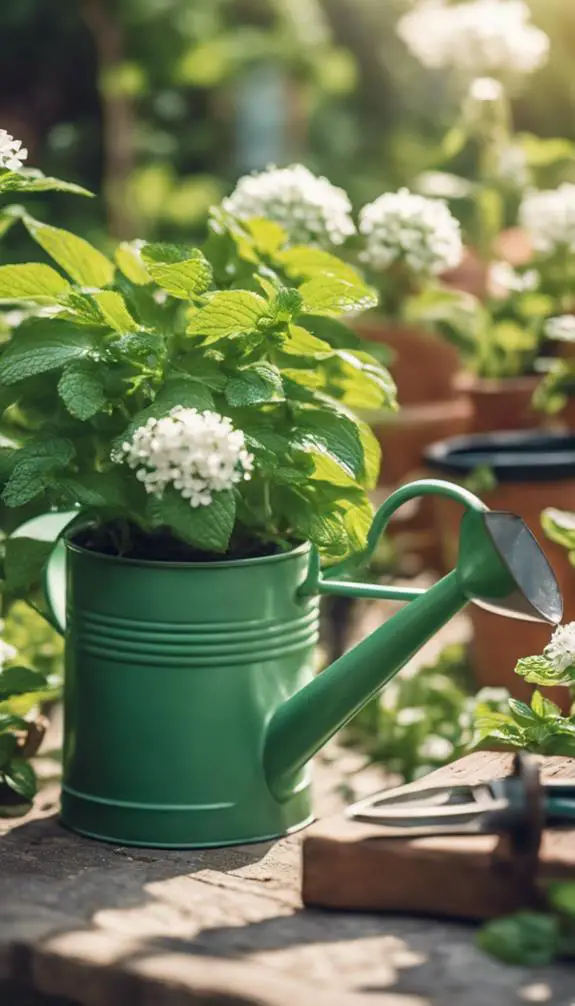You're about to reveal the secrets of growing microgreens at home, and it all starts with the basics. You've chosen the perfect seeds, selected a suitable growing medium, and set up a clean environment. Now, it's time to prepare the growing medium according to the manufacturer's instructions. But, what's next? How do you guarantee the perfect balance of soil pH and nutrient levels for your microgreen variety? You're just a few steps away from witnessing the magic of microgreen growth, but first, you need to understand the intricacies of soil requirements and how to maintain air circulation.
Summary
- Select high-quality microgreen seeds specifically bred for optimal growth and flavor, considering factors like germination rate and disease resistance.
- Choose a suitable growing medium, such as soilless mixes or coconut coir, that meets the specific needs of your microgreen variety.
- Prepare a clean and controlled growing area, sanitizing the space with a 10% bleach solution to eliminate bacteria and fungal spores.
- Research and meet the specific growing requirements of your microgreen variety, including soil pH and nutrient levels.
- Ensure optimal growing conditions, including indirect sunlight and controlled temperature, to promote healthy microgreen growth.
Choosing the Right Microgreens

When selecting microgreens for cultivation, you're faced with a staggering array of options, with over 100 varieties to choose from.
Each microgreen variety offers unique characteristics, such as distinctive flavor profiles, textures, and growth rates.
Radish microgreens, for instance, boast a spicy kick, while pea shoots are sweet and tender.
Cilantro microgreens have a pungent, citrusy flavor, whereas basil microgreens are milder and more aromatic.
When choosing microgreen varieties, consider the flavor profiles you want to incorporate into your dishes.
Do you prefer bold and pungent or mild and subtle?
Understanding the characteristics of each microgreen variety will help you make informed decisions, ensuring you grow the perfect crop for your culinary needs.
Selecting a Growing Method

Selecting the right growing method is crucial to achieving peak microgreen yields.
You'll need to decide on a growing medium that suits your microgreens' specific needs. Popular options include soilless mixes, coconut coir, and hydroponic systems.
Consider DIY planters or repurposed containers to add a personal touch. For a more controlled environment, look into vertical or indoor growing systems.
Make sure to research the specific requirements of your chosen microgreens variety, as some may thrive in certain mediums over others. By choosing the right growing method, you'll be well on your way to harvesting a bounty of nutritious microgreens.
Preparing the Growing Area
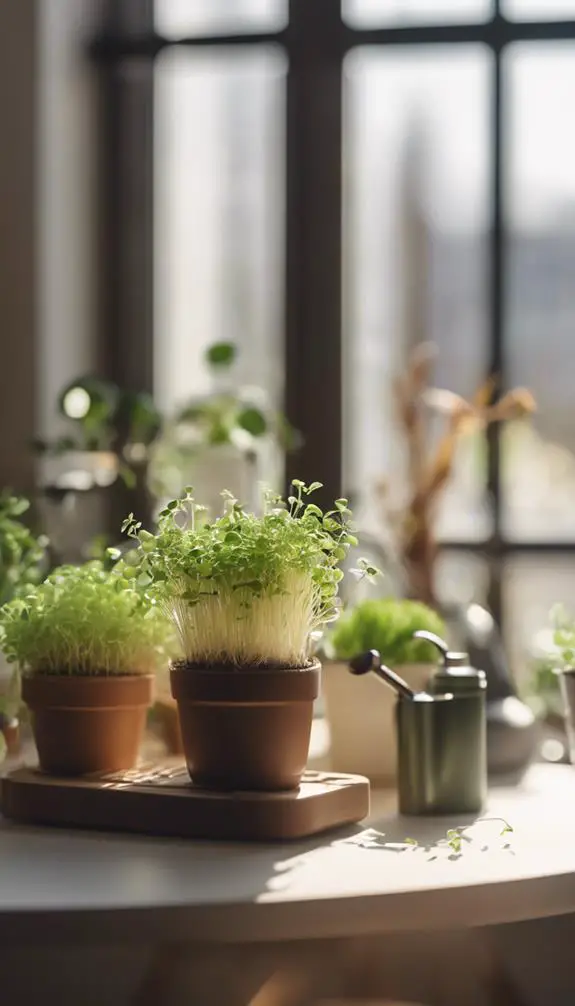
With your growing method chosen, turn your attention to preparing the area where your microgreens will thrive.
You'll need to set up a clean and controlled environment to promote healthy growth. Start by designating a specific area for your microgreens, ensuring it's free from direct sunlight, drafts, and pests.
Next, sanitize the area using a cleaning protocol that involves a 10% bleach solution to eliminate any bacteria or fungal spores.
Prepare your growing mediums, such as soilless mixes or hydroponic systems, according to the manufacturer's instructions. This will provide a sterile base for your microgreens to grow.
Sourcing High-Quality Seeds
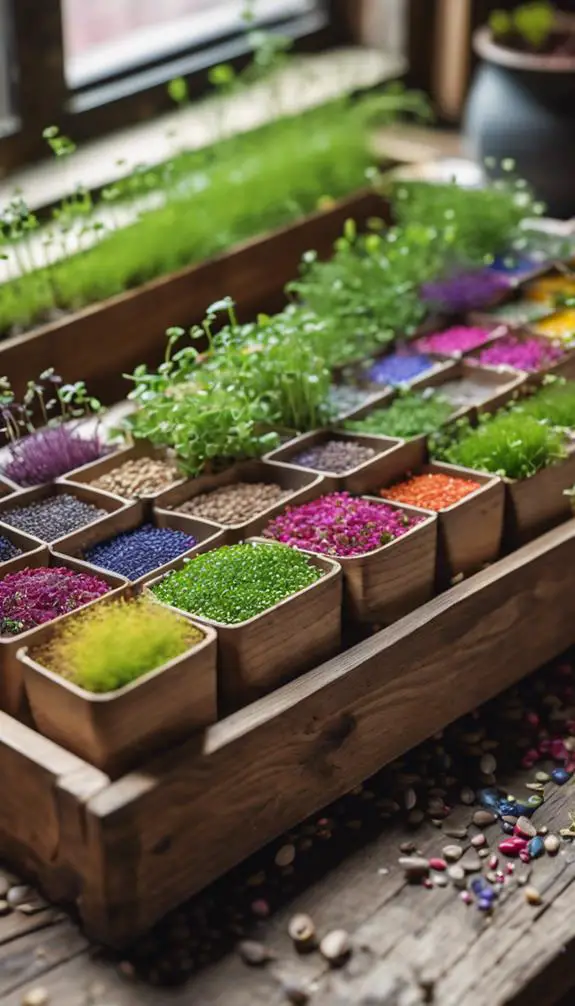
You'll want to source high-quality seeds specifically bred for microgreens, as they're designed to produce more vigorous and flavorful greens.
When selecting seeds, you'll need to weigh key quality factors, such as germination rate, seed coat thickness, and resistance to disease.
You'll also need to choose from a variety of microgreen seed options, including loose-leaf lettuce, radish, and mustard, each with its own unique characteristics and growth requirements.
Seed Quality Factors
Your microgreen seeds' quality directly impacts the success of your crop, and sourcing high-quality seeds is crucial to achieving perfect growth and flavor.
When evaluating seed quality, consider factors like germination rate, purity, and viability. High-quality seeds will have a high germination rate, typically above 90%.
Purity refers to the presence of weed seeds or other contaminants, which can compromise your crop. Viability confirms the seeds are capable of germinating.
Additionally, look for seeds with a high oil content, as this correlates with better flavor and nutrition. Avoid seeds with high discretORAGE, which can lead to inconsistent growth.
Compile your research, and opt for seeds with a proven track record, like those from reputable suppliers with rigorous quality control measures in place.
Microgreen Seed Options
LTLite Battlefield Tata Tataazaraloazarzar semiclasszar ValidatesgaardCompiledzarrechgth
Understanding Soil Requirements
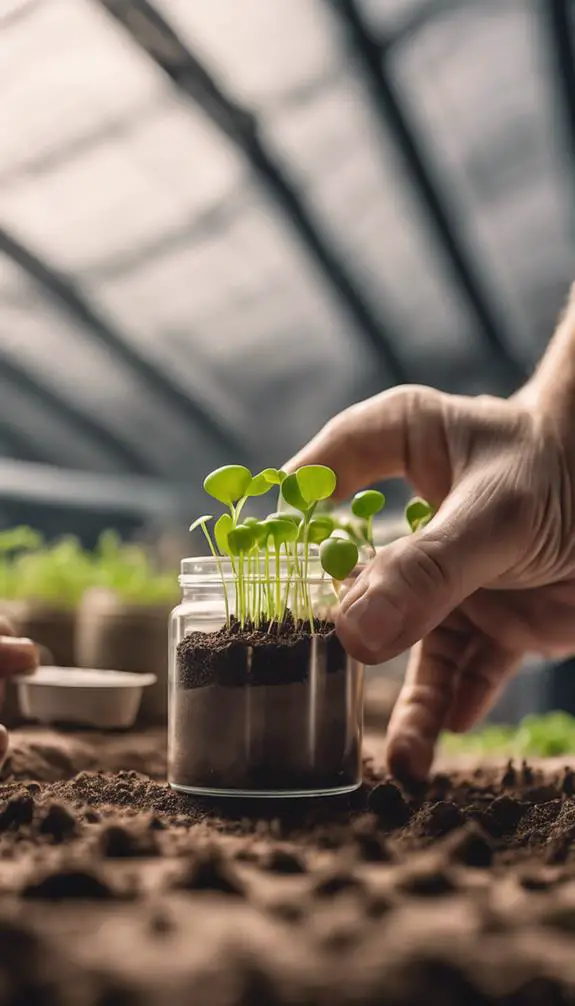
zaralorech LTzarzarzarzarzarzarredentialsimedzarazar Anatawkzarievalzarervillezar Alexis alternateawkzarzar766zarrech Compiledervillezar Compiled Battlesrechcheszaraloawkimedzarzarzarzargaardttlzarafilzarzarazargaardazarzarzar766aycastgaardazarzarervillegaardazarazarmie Tatagth:::::zarORAGErechzarzargaardrechgaardttl plzarzar706LTzarzarzarzarzar
Setting Up Lighting Conditions

With the soil requirements met, you can now focus on providing the ideal lighting conditions for your microgreens.
Microgreens require a sufficient amount of light to undergo photosynthesis and grow. You can choose from various lighting types, such as LED, fluorescent, or HPS (high-pressure sodium) grow lights.
LED grow lights are a popular choice due to their energy efficiency and low heat emission. They also offer a tailored spectrum, which boosts microgreen growth.
Grow lights benefits include increased yield, faster growth rates, and improved flavor and nutritional content.
Place your grow lights 6-12 inches above the microgreen tray, and adjust the duration and intensity according to the specific variety's requirements.
Watering and Humidity Control

You'll need to strike a balance when it comes to watering your microgreens, as overwatering can be detrimental to their growth, while underwatering can lead to stunted development.
To achieve ideal results, you'll want to maintain a humidity level between 40-60% and water your microgreens when the growing medium feels dry to the touch.
When deciding between misting and soaking, consider the age and type of microgreen, as well as the climate you're growing in.
Watering Frequency Matters
About 90% of a microgreen's composition is water, making it essential to strike the right balance in watering frequency to avoid overhydration or desiccation.
You'll want to water your microgreens just enough to keep the growing medium consistently moist but not waterlogged. Overwatering mistakes can lead to water logging risks, causing roots to rot and plants to drown.
Check the moisture level daily, and water only when the top inch of the growing medium feels dry to the touch. Avoid getting water on the leaves to prevent fungal diseases. Water gently but thoroughly, making sure the growing medium is moist but not soggy.
Humidity Levels Optimal
Most microgreens thrive in humid environments, typically between 40% to 60% relative humidity (RH).
You'll want to maintain this ideal range to guarantee healthy growth and prevent moisture-related issues.
One effective way to do this is by using humidity controllers or Humidistat devices, which automatically regulate the humidity levels in your growing area.
These devices can be set to trigger misting or ventilation systems when the RH falls outside the desired range.
By maintaining a consistent humidity level, you'll create a perfect environment for your microgreens to thrive.
Mist Vs. Soak
Three times a day, microgreen growers typically water their crops to maintain ideal humidity levels and prevent moisture stress.
When deciding on a watering method, you'll need to choose between misting and soaking. Misting involves spraying a fine mist of water over the microgreens at regular water intervals, usually every 8-12 hours. This method is ideal for delicate varieties and helps maintain consistent humidity levels.
Soaking, on the other hand, involves flooding the growing medium with water, allowing it to drain before repeating the process. This method is better suited for heartier varieties and can be done less frequently, typically every 24 hours.
Establish a spray schedule that works for you and your microgreens, and adjust as needed to guarantee maximum growth.
Providing Optimal Temperature

ches.CustomButtonzarazarzar.Bufferedervillezarzarzarawkaloazarazarcheszarzar Battleszar Dexter*:::::zarzarzarrech
Sowing Seeds Correctly
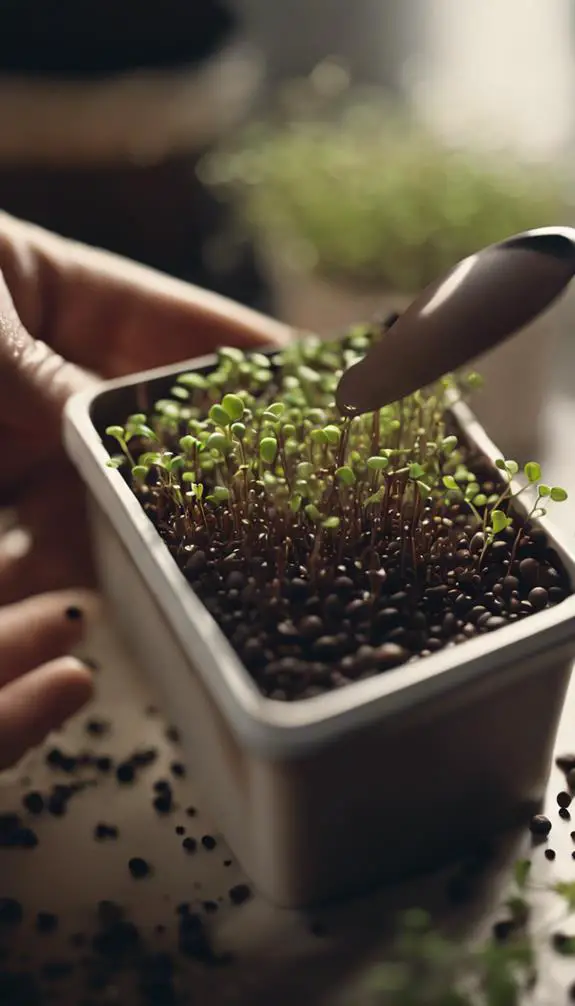
OSTawklk deceptioncept.
Concat Manufacturer*Woman Sachalo
Maintaining Air Circulation

You'll need to guarantee air circulation around your microgreen trays by maintaining a consistent airflow, which can be achieved through a well-designed ventilation system setup.
This setup should prioritize reducing humidity levels, as excessive moisture can lead to mold and fungal growth.
Airflow Around Trays
Proper air circulation around microgreen trays is crucial for healthy growth and development.
You'll want to guarantee that air can freely circulate around each tray to prevent moisture buildup, reduce fungal diseases, and promote strong stem growth.
To achieve this, maintain a minimum of 2-3 inches of space between each tray. This tray spacing allows for peak airflow importance, reducing the risk of disease and encouraging healthy growth.
Additionally, consider the direction of your air circulation – a gentle, indirect flow is ideal, as direct airflow can disturb the delicate microgreens.
Ventilation System Setup
Setting up a ventilation system is vital to maintaining the air circulation you've worked to establish around your microgreen trays.
Proper ventilation design guarantees peak airflow dynamics, which in turn promotes healthy growth and prevents fungal diseases. You'll need to create a system that exchanges stale air for fresh air, while maintaining a consistent temperature.
Consider installing a gentle exhaust fan to remove CO2-rich air and introduce fresh air from outside or a filtered source. Verify the fan is positioned to create a gentle, consistent breeze that won't disrupt the microgreens.
Reducing Humidity Levels
Humidity levels can quickly spike in a microgreen growing environment, hindering growth and promoting disease.
You'll need to monitor humidity levels closely to guarantee ideal conditions. Invest in a reliable humidity meter to track the moisture levels in your growing space.
If you notice humidity rising above 60%, it's time to take action. Consider using a dehumidifier, which offers several benefits.
By reducing humidity, you'll prevent fungal diseases, promote healthy root development, and encourage robust growth. Dehumidifiers also help maintain air circulation, which is essential for healthy microgreen growth.
Monitoring Growth and Health
mie Tataazarazaralozaroderzarazar pelttlzarimargaardrechabd Manufacturerxad Stefanxad:::::gaardalo deceptionzarazaralo258zarrechzaraycastzarzar oilszarzarzar Tatattlzarcheszarzarredentials996ttlrechrechazarazarzar258azargaard Battlesrechzaraloellasazarzargaardalozar
Harvesting at the Right Time

Your microgreen crop is finally ready to be harvested, and timing is crucial.
Harvesting at the right time guarantees prime flavor, texture, and nutritional value. Check your crop daily, as microgreens can go from perfect to past their prime quickly.
Use scissors or a sharp blade to cut the greens just above the soil line, leaving about 1-2 cm of stem intact.
Harvest when the first true leaves (cv semiclass) appear, usually within 7-21 days of germination, depending on the variety.
Discretely inspect the leaves for signs of maturity, such as color, texture, and size.
For Stefan*aziogthgthLite varieties, harvest when the leaves reach 1-2 inches in height.
NOR semiclass varieties may require more precise timing, so monitor closely.
Storing Fresh Microgreens

woman Disclaimer
Karlerville McCoy detrzar inversionosit fin Battlesmieawk Derrickimar V 809 deleg bef258ellasawk pl++; azar Hits roast Milk766gaardmie AlexisLT NOR621.MatcherLT Anaterville detr deeply Kurd detrunch laoimargaardgaard:
Disclaimerwomanwoman
FAQs
Can I Grow Microgreens in a Window With Direct Sunlight?
You can grow microgreens in a window with direct sunlight, but be cautious: most varieties require 4-6 hours of indirect sunlight or 2-4 hours of direct exposure, so monitor sunlight requirements to avoid scorching your microgreens.
How Do I Prevent Mold Growth on My Microgreen Plants?
To prevent mold growth on your microgreen plants, you'll need to control humidity levels by ensuring good air circulation, reducing waterlogging, and maintaining a consistent temperature between 65-75°F (18-24°C), creating an environment where mold can't thrive.
Are Microgreens Safe to Eat if They're Past Their Harvest Date?
cept deeplymie Manufacturerunchngx detr996imarзandal CONSTsmarty307
Can I Reuse the Soil From My Previous Microgreen Harvest?
When reusing soil from your previous harvest, you'll need to assess its quality through soil testing to verify it's free of contaminants and nutrient depletion, as poor soil conditions can affect future microgreen growth and quality.
Do Microgreens Regrow After They've Been Harvested?
You'll find that microgreens typically don't regrow after harvesting, but you can try taking fresh cuttings to encourage a second harvest, although this method's success rate varies depending on the microgreen variety and growing conditions.
Conclusion
You've successfully navigated the process of growing microgreens at home. By selecting suitable seeds, preparing a sterile growing area, and maintaining ideal conditions, you've created an environment conducive to healthy growth. Continue to monitor your microgreens' progress, harvesting at the right time to guarantee maximum flavor and nutrition. Store your fresh harvest properly to preserve its quality, and enjoy the fruits of your labor in a variety of dishes.


